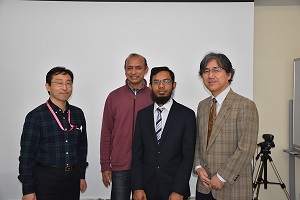From Ph.D. student at Shimane to postdoctoral fellow at Rowan
 As a Ph.D. student, I studied the neuroprotective role of a mesenchymal stem cell line (MSc) transplantation in an Alzheimer’s Disease (AD) rat model. An AD rat model was prepared by the continuous infusion of amyloid beta (Aβ1-42) into the left lateral ventricle through an osmotic pump for two weeks. The right lateral ventricle was pointed out during the AD model preparation. The right lateral ventricle was exposed to a single shot of the MSc line (2x105 cells/shot) after two weeks of AD model preparation. Sham group went for surgery only except for (Aβ1-42) infusion and or MSc transplantation. Sham, amyloid beta, and MSc transplant groups were sacrificed after four weeks of AD model preparation. Samples were saline perfused, post-fixed in formaldehyde solution, and brain tissue was collected over slides for different sorts of immunohistochemistry experiments. Half of the brain samples were also collected for real-time polymerase chain reactions.
As a Ph.D. student, I studied the neuroprotective role of a mesenchymal stem cell line (MSc) transplantation in an Alzheimer’s Disease (AD) rat model. An AD rat model was prepared by the continuous infusion of amyloid beta (Aβ1-42) into the left lateral ventricle through an osmotic pump for two weeks. The right lateral ventricle was pointed out during the AD model preparation. The right lateral ventricle was exposed to a single shot of the MSc line (2x105 cells/shot) after two weeks of AD model preparation. Sham group went for surgery only except for (Aβ1-42) infusion and or MSc transplantation. Sham, amyloid beta, and MSc transplant groups were sacrificed after four weeks of AD model preparation. Samples were saline perfused, post-fixed in formaldehyde solution, and brain tissue was collected over slides for different sorts of immunohistochemistry experiments. Half of the brain samples were also collected for real-time polymerase chain reactions.
As a postdoctoral fellow at the Cell Biology and Neuroscience Department of Rowan University School of Osteopathic Medicine, my current study is to understand the neuron immune axis of host-pathogen interaction. To understand the reason behind the gut-brain dysbiosis, we are using Caenorhabditis elegans as the host and Pseudomonas aeruginosa as the pathogenic bacterial food source of this model.
Usually, Caenorhabditis elegans are fond of non-pathogenic bacteria as their food source and avoid bacterial food lawns when pathogenic bacteria are supplied. More clearly, C. elegans showed opposite behavioral patterns in response to pathogenic and non-pathogenic bacterial food sources during the experiment. It is our target to know the reason behind the withdrawal effect of this model nematode against Pseudomonas aeruginosa (pathogenic) bacteria as their food source. During the initial exposure, C. elegans enjoyed taking this pathogenic food, interestingly after a few hours refused to eat more, and avoided the food lawn. At this time, reactive oxygen species (ROS) production is increased and the SOD-1 enzyme mitigates this refusal to change the gut-brain function to stay in food lawn. However, in amyotrophic lateral sclerosis (ALS) disease, ROS production is not controlled due to a lack of SOD-1 enzymatic activity. Now, I am trying to unravel the actual reason behind this withdrawal behavioral pattern of this nematode using the genetic variation of superoxide dismutase enzymes (SOD-1, SOD-3, SOD-4, SOD-5 including transgenic strains) besides the ROS-mediated toxicity.
It is my immense pleasure to share the contribution of the knowledge received from the Medical School of Shimane University, Japan, as I make a milestone in reaching my next career goal here in the USA. I must mention to you about Professor Atsushi Nagai’s laboratory in the Department of Laboratory Medicine at Izumo Campus. Associate Prof. Shozo Yano and Dr. Sheikh Mohammad Abdullah were generous enough to make a framework for learning research and building up new ideas and thoughts to implement new methodologies. I already knew about high-performance liquid chromatography (HPLC) techniques before starting my Ph.D. study. Interestingly, my supervisor created an environment to update my knowledge and excelled in LC-ESI-MS/MS methodologies. I was able to perform a phospholipidomics study including plasmalogen in a J20 transgenic mouse model. Now, I am expecting to create a new research option in the lipidomics study area. However, my molecular study during the graduation period helped me a lot to learn the basic knowledge in PCR, genotyping, phenotyping, and immunohistochemistry experiments. The preparation of C. elegans genetic markers is now a common task in my project which is simple and easy. I just need to maintain mating with hermaphrodites with males and then wait for F2 and F3 progeny to isolate the correct progeny by confirming in PCR and Gel run. It is also interesting to create new transgenic strains of SOD-3P Hypher Red using chromosomal rearrangements.
I would like to express my positive opinion to those students who are seeking admission in both the Ph.D. and Master’s course at Shimane University. Academic and research facilities provided by Shimane University are ranked in the top class. As a student, you have to learn the research profoundly to make yourself skillful in your research area. A lot of opportunities are waiting for you. In my case, I went back to my country, Bangladesh, just after completing my PhD study in March 2019. Interestingly, I was out of research for about three years during the pandemic. Usually, it is difficult to enter the USA if there is any gap in research after the Ph.D. That’s why I was worried about my next career goal in the USA. Luckily, I received another opportunity as a postdoc fellow at Medi-Quality Security Institute (MQS), Kanazawa University to enter Japan again in March 2022. After that, it was very easy for me to get my present opportunity at Rowan University. Consistent efforts for research and a hard-working ability will be your key points to success in your next research goal after a Ph.D. and/or Master’s program at Shimane University. I hope for your every success in your upcoming research career at Shimane University and onwards.
by MD. AHSANUL HAQUE, October 2023